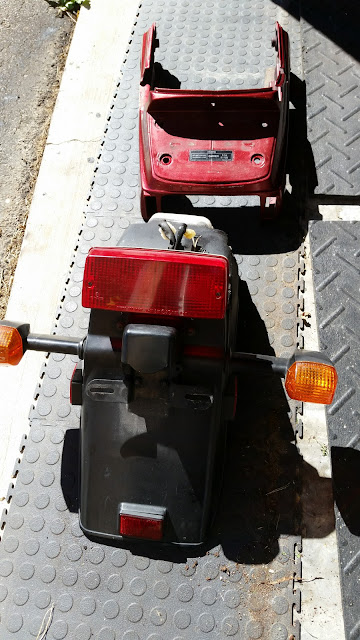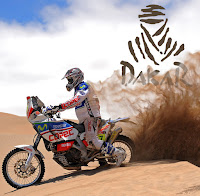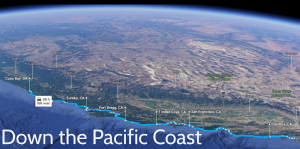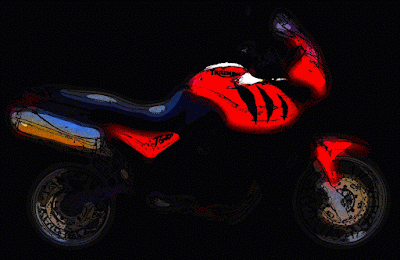Naked Connie
 I put the Concours up for sale for a very reasonable $1200 and immediately got a bunch of low ball offers. After a week of talking to cheap idiots I pulled it back off Kijiji, this bike deserves better than that. I sympathize with people who can’t afford the hobby, but I never agreed to support that charity.
I put the Concours up for sale for a very reasonable $1200 and immediately got a bunch of low ball offers. After a week of talking to cheap idiots I pulled it back off Kijiji, this bike deserves better than that. I sympathize with people who can’t afford the hobby, but I never agreed to support that charity.
Jeff’s recent adventures with getting an old bike to modify into a cafe racer got me thinking about what a naked Concours might look like. The ZG1000 is based on the Ninja sport bike (one of the reasons it’s so agile), so as a donor bike it has a lot going for it. I wasn’t the first to wonder…
 |
| It shows how clean you can make the engine and wiring without all the plastic covers, not radical enough though. |
 |
| Love the paint on the gas tank. It makes me look forward to stripping mine. No airbox and exposed air filters are sweet. |
 |
| Stripped down but looks half finished. |
 |
| Front and rear fenders are sweet. Suspended seat and tail look a bit awkward though. |
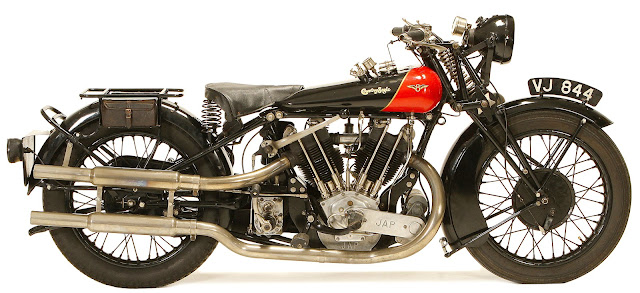 |
| I’m interested in a single seat saddle, not so much for a bobber look, but for a historical connection. |
I stripped off the front fairings, mirrors and windshield. That has to be about twenty pounds right there. At the back I removed the pannier frames and the rear tail light assembly. That’ll be another easy ten pounds worth of odds and ends. By the time I’m done, this bike will be an easy 100lbs lighter.
The entire rear frame that holds the panniers, seat and rear light assembly is bolted on under the seat. Removing it seems pretty straightforward. With the rear frame gone, the Concours starts to look more like a streetfighter than a sport tourer. With the back end gone it was easy to remove the rear tire and get into the shaft drive which has been leaking.
While I was stripping things down I removed the bar risers, which lowered the controls a couple of inches and further lightened the bike. With all the plastic and back end metal work off, the bike has already undergone a dramatic diet. People tend to pick smaller, lighter bikes to cafe, but as I’m neither small nor light, the Concours makes for a big, muscly and quiet unique power cafe racer project.
With everything in the process of a strip down, I was easily able to get the back wheel off and uncover the shaft drive axle. It’s been leaking, but some research on CoG (the Concours Owners Group, which I just re-upped my membership on) suggested that a leaking shaft drive can be the result of over filling, which it was. I’m going to clean it all up, fill it to spec and then keep an eye on it before I go all crazy tearing it down (which looks like a hassle because you’ve got to heat parts to get them apart).
I’m hanging on to the Concours because of some magic moments on it. The sound of that engine at full song is exceptional. The thought of giving it away after all the work done grates on my nerves as well, especially to some tool who is just looking for a handout (one guy, after trying to talk it down $500 then complained about the state of the fairing – screw him). Had I sold the Connie I’d have gone looking for a bike I could strip down and customize. Hanging on to the Concours means I’m doing that with a low mileage bike full of new parts. One that I’m already really familiar with.
Since I’m not depending on the Concours to be my everything bike any more it can become a blank canvas, which is what I was looking for in the first place. A stripped down, restyled Concours isn’t going to be a Concours any more, but it is going to exploit that big Ninja engine and nimble handling it already had. Best of all, I get to hang on to those fantastic gold rims, and build up a custom around them. Much better that than my resurrected ZG1000 going to motorcycle welfare.
 |
| Even the instrument cowl is a big, heavy old thing. I’m aiming for an analogue speedometer and then a microprocessor controlled LCD screen. |
 |
| Don’t know if I’ll keep the Ironman theme, but I might, it’s eye catching. |
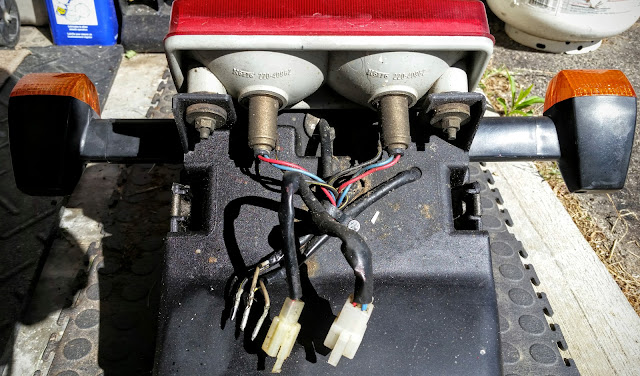 |
| Someone somewhere might be looking for just this thing! |
 |
| I’m going to take a note from Jeff and see if I can sell off parts others might need for their complete Concours in order to help pay for the bits I need for mine. |
 |
| Bar riser still on to the left, the one on the right is a couple of inches lower. |
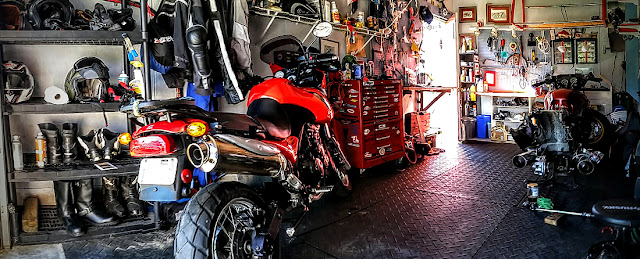 |
| With the mystical, multi-talented Tiger on hand, the Concours can take its time becoming a specialist. It seems happier with that prospect. So am I. |
A Winter without Winter
These little imaginings are a nice escape, and if I ever become pointlessly rich, I’ll be able to torment friends and family who ride with ridiculous Top Gear like challenges.
I’ve been monkeying around with Furkot and have come up with a themed trip to the end of South America and back. Starting in October, just as the darkness and cold is closing in on Canada, we head south. Over the next six months while ice and snow reign in the north, we enjoy equatorial heat and spring in the southern hemisphere.
We reach the southern terminus of our trip in mid-winter/summer (December 21st) on the longest day, and then begin the climb back up the globe on the other coast of South America before finally stopping in Rio and shipping the bikes back to NYC. With the best part of three months to get south, this isn’t a ragged rush to the end and should offer time to really get a sense of the places we’re passing through.
We’d be in Buenos Aires two weeks after Ushuaia, coincidentally, just when the Dakar Rally kicks off, which would be an exciting thing to try and follow on lightened motorcycles (we could store most of our luggage in B.A. while we chased the race).
The Dakar wraps up in mid-January after we follow it into the Andes and through Bolivia before coming back to Argentina for the start/finish. We’d recover in Buenos Aires and then begin making our way north into Brazil. A tour of Brazil would have us seeing the Amazon before coming back down to Rio.
If we left South America from the port of Rio and headed back to New York City, it would take about three weeks on a slow boat; a good time to rest, recover and write!
The final piece would be the two day ride home from NYC to Southern Ontario in April, just when we’re ready for spring in Canada.
The Five Thousand Dollar Challenge
The evil-rich me would offer to pay for the trip, but we’d be riding the whole way on bikes that cost less than $5000 Canadian (Top Gear style).
I’m still crushing on Tigers. I think I could talk this one down to $4200 to get it under the $5000 limit with taxes.
$5000 limit with taxes.
An oil change and a check of the obvious bits (chain, tires, cables) and I’d be ready to go.
The North American bit will be a lot of tarmac, but the Central and South American bits will take some tougher tires, which I’d aim to pick up en route.
A quick trip to Twisted Throttle (who have a whack of 1050 Tiger gear) and I’d be ready to take on the escape from winter.
With a $5000 limit on the bike (taxes in), what would you take?
Some 1050 Tiger Farkling
Engine Guard
http://www.twistedthrottle.ca/sw-motech-crashbars-engine-guards-triumph-tiger-1050i-07
Skidplate
http://www.twistedthrottle.ca/sw-motech-aluminum-engine-guard-skidplate-triumph-tiger-1050-07-black-or-silver
Tires for Central/South America
http://www.twistedthrottle.ca/continental-contitrailattack-2-dual-sport-front-17-inch-size-120-70-17-90-street-10-dirt-58w-tubeless-bias-ply-tire
Hand guards
http://www.twistedthrottle.ca/barkbusters-vps-handguard-triumph-tiger-1050-with-28mm-diameter-barkbusters-aluminum-handlebar-installed
Ride Planning Tools: Furkot
Another benefit of doing a trip as a class project was pushing me to find alternatives to Google Maps, which I generally use for trip planning. It makes pretty maps and I like that I can get a sense of what I’m looking at through street view and satellite imagery. It’s relatively easy to use and lets you quickly put together distances, though not easily in segments.
| Google Maps lets you switch to Google Earth view and show the geography of the area (in this case The Twisted Sisters – the top motorcycling road destination in the US). It makes for pretty maps, but I had to add in extra waypoints to keep it off the boring highways and on the interesting tarmac. |
Where Google Maps really falls short is on longer trip planning as it tends to be car focused and can’t understand why anyone wouldn’t want to sit on an interstate all day in a box. Trying to coerce Google Maps onto twisty roads is a tricky business, especially with limited way point options. You quickly run out of pins to stick in the map when you’re constantly fighting the software’s predilection for making your trip as short and boring as possible.
Being back in the classroom has me looking for escapism, so I’ve been reading ADVrider’s Epic Ride Reports. There is nothing like reading a ride report from someone’s RTW trip to set you free from a regimented schedule. While on there I came across a couple’s ride from Toronto and around the US. Chelsey was planning their trip on Furkot, which I’d never heard of before. This piqued my interest because some of my students would benefit from an easier/more fully featured digital trip planner.Getting into Furkot was pretty straightforward, you can login using a social media account. It took me about five minutes to transfer my pieces of Google Map from my road trip project into it, and there were no stingy limits on way points.
It was when I got into the details that Furkot really lit up. Not only does it auto-set your stops for each day based on what you think your mileage is going to be, but it’ll also find you hotels and preset you gas stops based on the range of your vehicle.
When you make a map you can keep it private or share it, and if you share it you immediately get a link to it. Furkot also gives you a share page which has more social media connections (left) than I thought existed, so it shares well.
I only monkeyed around with it for twenty minutes, but I feel like I haven’t even scratched the surface. You can set your trip to your vehicle and I get the sense that a motorcycle selected trip gives you motorcycle specific results. I look forward to sharing it with my class tomorrow as well as playing with it more myself.
 |
| Where the journey’s the thing… |
In the meantime I’ve been thinking about Google Maps. The API for Maps is open and used by lots of people to create custom mapping applications. Had I more free time on my hands I’d get into it and build out a motorcycling focused mapping app using Google Maps. The idea came up at the Lobo Loco rally as well. A rally specific app that allows for many GPS way points and more motorcycling focused roads would be a real treat. As would a simplified interface that would work from the busy and limited input environment of a motorcycle saddle.
A simplified G-Maps that focuses on the ride would be a cool project.
Sharing Interests to Prompt Self-directed Writing
The idea of genuine communication and showing students teachers as people rather than representatives of the education system has appeared several times on the PLN lately. Consequently, transitioning from summer to the school year has me overlapping my writing subjects. This was originally published on Tim’s Motorcycle Diaries…
I’m back in the classroom again and teaching English for the first time in more than a year. I took a senior essentials English class mainly because few people want to teach it (teachers like to teach people like themselves – in this case academically focused English students), and it fit my schedule. Essentials English is just as it sounds. These are weak English students who are getting what they need to graduate and get out into the workplace, they aren’t post-secondary bound and tend to find school pointless.
The trick with students this bullied and indifferent to the school system is getting them to read and write at all. Rather than drag them into a text book or make them watch the department copy of Dead Poets Society in order to prompt some writing, I thought I’d introduce them to my insanity. In a week where we’re all getting to know each other it helps if students see what you’re into. Showing your hobbies and interests is a good way to have them become familiar with you and relax a bit. If they get excited about the idea of planning a trip and it prompts them to write, it’s a many birds with one stone situation.
 |
| With some support, students quickly got into planning a trip. 28 days, unlimited budget! |
The plan was pretty straightforward: you’ve got four weeks (28 days) starting next Monday. Assume you’ve got an unlimited budget for a road trip (gotta travel on the ground). Where would you go? What would you do? On the second day I gave them some pointers on Google Maps and some planning tools like a calendar and how to make notes online and they were off. At the moment it looks like I’ve got pages of writing from students who generally don’t. The research they’ve been doing also lets me diagnose their reading level.
Needless to say, I bravely volunteered to present first. It doesn’t feel like homework when you enjoy doing it, and mine was obviously going to be a motorcycle trip. I probably could have gone more bonkers on bike choice, but I have a sentimental attachment and some practical necessities that prompted my choice (all explained in the presentation). Rather than go for the South American adventure, I decided to focus on The States, which has tons to offer, especially if you aren’t sweating the budget.
Norman Reedus’ RIDE gave me an idea of where I’d like to go, the question was, could I get to the locations in the show and back home in 28 days?
Here’s what I’m presenting:
 |
| That photo I doctored of a VFR800 a couple of years ago came in handy! |
Another side benefit of something like this rather than a boiler plate reading and writing diagnostic is that is gives students a lot of control over the direction of their writing, which means I get to learn what they’re into, which helps me remember who each person is as well as offering me relevant subjects I can insert into future projects.
I’m hoping they surprise themselves with the results. If I catch some of them in the future staring wistfully at Google Maps instead of playing pointless FLASH games I’ll know that they’ve been bitten by the travel bug too!
 |
| Into the Rockies ASAP, then down the coast, across the mountains again, and then up the Appalachians home. |
 |
| Multiple destinations on Google Maps is a simple enough process if you know how. Everyone does now. |
 |
| Yellowstone! Riding over a mega-volcano. No one in the class realized we lived so close to this impending disaster. It led to an impromptu Geography lesson. |
 |
| Death Valley and across the South West to the Twisted Sisters on the way to the Big Easy. |
 |
| Back north in the Smokey Mountains and Appalachians. |
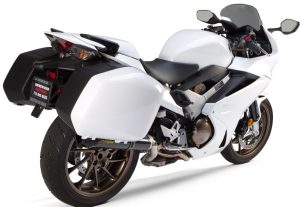 |
| I was thinking maybe an H2R or RC213 in a trailer, but then that meant driving a truck and trailer all over the place. Better to be on two wheels all the time, and on the descendant of my first bike crush. Students were very curious about my choices. How you travel says a lot about you. |
Lobo Loco: The Birds & The Bees Rally
 |
| You couldn’t possibly hit them all, so route selection is key. |
 It’s a sleepy, summer, Saturday morning in Elmira. The few locals that are already up are walking dogs and taking it slow, but the clock has just ticked over to 8am and we’ve begun our first long distance motorcycle rally. We fill up, get a receipt showing our start time and place and text to the rally lead that we’ve started. We rode over to Elmira to start because this is a target rich environment with over 1500 points on tap.
It’s a sleepy, summer, Saturday morning in Elmira. The few locals that are already up are walking dogs and taking it slow, but the clock has just ticked over to 8am and we’ve begun our first long distance motorcycle rally. We fill up, get a receipt showing our start time and place and text to the rally lead that we’ve started. We rode over to Elmira to start because this is a target rich environment with over 1500 points on tap.
 The theme of this rally was birds and bees, so locations had some kind of connection to that idea and included everything from apiaries to bird statues. Since neither of us enjoy urban riding on hot summer days, we plotted a route that would take us cross country and out to the shores of Huron before looping back around to Brantford. Being new, we were afraid we’d bite off more than we could chew; we did anyway despite reducing our route goals half a dozen times.
The theme of this rally was birds and bees, so locations had some kind of connection to that idea and included everything from apiaries to bird statues. Since neither of us enjoy urban riding on hot summer days, we plotted a route that would take us cross country and out to the shores of Huron before looping back around to Brantford. Being new, we were afraid we’d bite off more than we could chew; we did anyway despite reducing our route goals half a dozen times.
 The bee beard was brilliant, as was Clovermead in general. A rally like this shows you all sorts of local spots you’d otherwise have no idea about. I was thinking about this as we got out to the bikes only to be told by Google maps that we were an hour away from the finish line with an hour to go! Perhaps the bee beard was a trap! We’d been tired but adrenaline kicked in again, the race to the finish was on! We got back to the 401 and flew on down the 403 elated that we’d made the bee beard bonus but anxious about getting to the finish. The traffic light coming off the highway felt like it was red for an hour! We pulled into King’s Buffet parking lot, already full of motorcycles of all shapes and sizes, at 3:56pm; that’s tight!
The bee beard was brilliant, as was Clovermead in general. A rally like this shows you all sorts of local spots you’d otherwise have no idea about. I was thinking about this as we got out to the bikes only to be told by Google maps that we were an hour away from the finish line with an hour to go! Perhaps the bee beard was a trap! We’d been tired but adrenaline kicked in again, the race to the finish was on! We got back to the 401 and flew on down the 403 elated that we’d made the bee beard bonus but anxious about getting to the finish. The traffic light coming off the highway felt like it was red for an hour! We pulled into King’s Buffet parking lot, already full of motorcycles of all shapes and sizes, at 3:56pm; that’s tight! Staggering into the dimness of the restaurant I felt sun-blind. We drank lots of water while we wrote out a clean copy of our rally sheet that had to show times and odometer readings for each stop along with a photograph showing us and our rally flags in each location. A rally volunteer then checked off each photo making sure that it fulfilled the criteria. Most people hadn’t eaten during the day so the all you can eat buffet went down well while we handed in scores and had our photos checked.
Staggering into the dimness of the restaurant I felt sun-blind. We drank lots of water while we wrote out a clean copy of our rally sheet that had to show times and odometer readings for each stop along with a photograph showing us and our rally flags in each location. A rally volunteer then checked off each photo making sure that it fulfilled the criteria. Most people hadn’t eaten during the day so the all you can eat buffet went down well while we handed in scores and had our photos checked.
 Everyone cheered and clapped as trophies went out for everything from the person who got most lost to the top scorers. Riders were awarded for smallest bike, 2-up and most efficient route as well as a raft of other prizes. The top riders scored almost double the points we did, showing real navigation and riding mojo. Afterwards lots of handshakes and names were exchanged and a lot of new friends were made. Revitalized after a big buffet dinner and all that good cheer, Jeff and I saddled up and waved to everyone as we rode into a welcome evening rain. I was only an hour away from home, but Jeff, after already riding almost 600kms, was going to put another 200kms on going to his cottage in Kincardine; that guy’s a machine!
Everyone cheered and clapped as trophies went out for everything from the person who got most lost to the top scorers. Riders were awarded for smallest bike, 2-up and most efficient route as well as a raft of other prizes. The top riders scored almost double the points we did, showing real navigation and riding mojo. Afterwards lots of handshakes and names were exchanged and a lot of new friends were made. Revitalized after a big buffet dinner and all that good cheer, Jeff and I saddled up and waved to everyone as we rode into a welcome evening rain. I was only an hour away from home, but Jeff, after already riding almost 600kms, was going to put another 200kms on going to his cottage in Kincardine; that guy’s a machine!
The rally website: http://lobolocorallies.ca
Want to sign up for October? It’s happening again in the spring!
 |
| Our first stop 500 feet down the road from the gas station we filled up at. By 4pm we were over 500kms covered, but we also went further than anyone else. |
 |
| I had no idea this was on the way to Stratford. I intend to go back and have lunch! |
 |
| Ya gotta hit a lotta apiaries to win top bee keeper! |
 |
| How to hold a rally flag down at a windy big bird on the Avon in Stratford – no swans out yet though, so no swan bonus 🙁 |
 |
| A welcome sign to a town starting with B! 100 points! The grass was all trampled down around the sign, we weren’t the first. |
 |
| The closest I got to a bee beard. |
 |
| Another spot I’d like to return to. Some prime objects d’art for the garage in there! |
 |
| The last stop before our final highway bombing run to the Brantford finish line. |
 |
| One of only a couple of stops that were biological rather than rally targets. Jeff’s Super10 and my Tiger were flawless. |
 |
| The difference between these patches and others you might see is that these patches denote hardcore motorcycling skills over astonishing distances and times. |
 |
| The good cheer was infectious after the rally. It didn’t matter what you rode, only that you rode it. |
 |
| Wolfe Bonham, the author of the inaugural Lobo Loco Birds & Bees Long Distance Rally. |
 |
| Jeff never says no to free gas! We plotted the longest route, but we spent very little time looking at traffic lights. |
 |
| Iron horses of many colours – you’ll find everything from the RTW adventure bike to big cruisers and tiny nakeds on a long distance rally. |
 |
| He’s been everywhere man, he’s been everywhere. |
 |
| From tiny Yamaha WT200s and KTM 390s to 1600+cc cruisers… there is no ‘right bike’ for a long distance rally. |
 |
| We all rode off into the twilight as rain started to fall lightly between lightning strikes. A suitably dramatic finish to an epic day. |
| We bit off more than we can chew, but still made it in with four whole minutes to spare! |
 |
| It now has pride of place next to the wine rack, and has left me looking forward to future rallies. |
| Jeff does more burn outs than me, so he got longest route. |
| We were aiming for mid-pack. It doesn’t get more mid-pack than 17/18 out of 34 finishers. |
https://goo.gl/maps/b2y9jWfa3oN2
https://goo.gl/photos/zYV2dJz5aViRUK298
https://rides.jasonjonas.com/riderList.php?rcid=0&id=438
http://wolfe35.wixsite.com/lobolocorallies/results
Whimsical Tigers

On our recent cross-Ontario ride we were stopped a number of times by people who were curious about the Tiger. This is an eye catching, obviously modern looking bike with a Triumph logo, it prompted questions. If they see a new ‘classic’ Triumph, most of the general public think it’s actually a classic. They wouldn’t recognize the difference between fuel injection and carburetors even if it’s advertised on the bike, they just see an old machine.
| Colourful Triumphs of yore. The Naughties were neon! |
The confusion of a new-looking Triumph (even though it’s 13 years old), and what they thought a Triumph should be isn’t too surprising, and I’m happy to fill them in on the triumphant return of the brand (it’s a good story), but it makes me question the modern bike colours and styles.
When we went to get the Tiger, 11 year old Max’s eyes bulged out of his head and I knew we had a winner. Who makes a Lucifer orange tiger with stripes? Triumph in 2003, that’s who. When they weren’t churning out violently orange Tigers, they were putting out a wild assortment of colours. Of course, this was before Ewan & Charlie jumped on their austere Bayerische Motoren Werkes R1200s and reset the aesthetic paradigm for adventure motorcycles.
| Why so serious? That muted blue is as close as you get to colour on a new Tiger. Other choices include military green or grey. A purposeful look is what sells adventure bikes nowadays… and don’t forget to dress like a starship trooper! |
Nowadays everything has to appear relentlessly purposeful and ridden by people who look like they’ve just landed on an alien planet. Whimsy and fun are replaced by bikes that look like they come from Army surplus, and riders who just got decommissioned from the special forces. No wonder people were eager to walk up and start a conversation with the guy and his son on their brilliantly orange Tiger that looks like it just popped out of Winnie the Pooh. The public wants to be curious about motorcycles, but a lot of motorcyclists seem determined to make themselves as unapproachable as possible, and manufacturers have to cater to that attitude in order to sell.
Besides paint options there is also the issue of styling. I find the compound curves and organic look of our 955i Tiger very engaging. Whomever was designing Triumphs in the early Naughties did it pretty much exactly the same way I would have. Since then Triumph, along with most other brands, have been chasing a more chiselled, hard edged look. Lamborghini did a stealth fighter aesthetic after the Diablo with crisp, folded edges and it seems to have spread. Between the muted colours, sharp edged styling and attitude driven rider styles, it’s little wonder that our whimsical Tiger had people approaching us.
I realize manufacturers have got to build to the tastes of the day, but I’m hoping there are a group of motorcyclists out there who aren’t so serious and miss those fantastic styles and colours. If there are, there is hope that my whimsical Tiger won’t be so exceptional in the future.
LINKS
| Even when they’re blue, they’re mostly black. |
https://rideapart.com/articles/what-the-color-of-your-motorcycle-says-about-you
Black motorcycles are dead sexy. No, really. Researchers at the University of Kentucky (March, 2011) found that in 36% of crashes involving a driver’s failure to observe a motorcycle and then turning into its path involved black motorcycles.
 |
| Army green, ready to attack those adventures! |
Looks like whimsical colours can keep you alive! It might be time to bring back peppermint green and neon puce!
http://www.motorcyclenews.com/news/new-bikes/2013/june/jun0413-triumph-releases-new-colours-and-a-sprint-gt-special-edition/
As the years go by, the colours get more and more muted.
| I like my Tigers Tigger-like… |
Triumph has a great sense of humour, just not with adventure bikes (those are very serious).
Finding Mountains
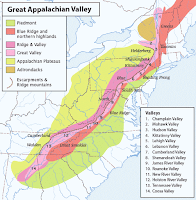 Way back in the late 70’s we were new immigrants living in Montreal. We got a handle on our new land by camping, a lot. One of the most memorable trips we took was down into the Adirondacks in the spring, where we camped in the mountains. It was the first time I saw a rainbow trout; North American animals are so exotic!
Way back in the late 70’s we were new immigrants living in Montreal. We got a handle on our new land by camping, a lot. One of the most memorable trips we took was down into the Adirondacks in the spring, where we camped in the mountains. It was the first time I saw a rainbow trout; North American animals are so exotic!I’d love to spend some time on two wheels somewhere nearby and mountainous, and the Adirondacks have a fond child-hood glow to them. I can access the back side of the Appalachians below the Adirondacks just a day’s ride south east of me.
Port Allegany: Hotel: https://goo.gl/maps/xcMq5EaycSK2
382kms https://goo.gl/maps/NNxxuSkwXD42
Bath Via Watkins Glen: Hotel: https://goo.gl/maps/UpQrfPgbUmG2
360kms + border https://goo.gl/maps/B8X7jBLSv4Q2
https://goo.gl/maps/4Y99C6Yqvky
277kms
Night 1: Salamanca, NY Hotel: https://goo.gl/maps/cCJEsbj5sDE2
358kms
Night 2: Carbondale, PA Hotel: https://goo.gl/maps/fE65se2ojSL2
390kms
Night 3: Auburn, NY Hotel: https://goo.gl/maps/fA3Mq5nxyRA2
375kms
https://goo.gl/maps/4hRgs1zMFdN2
https://goo.gl/maps/D4LvxiizbQu
https://goo.gl/maps/D8SZpTAZV4v
https://goo.gl/maps/w1W661WD9eE2
https://goo.gl/maps/tyz9u4UfjZQ2
400kms
Seneca Falls: Hotel: https://goo.gl/maps/YfbAvcATLsQ2
344kms
Watkins Glen: Hotel: https://goo.gl/maps/8ahZdPxZFh42
To One Thousand Islands
Things fell together just right for a ride out to the 1000 Islands in Eastern Ontario. My lovely wife had a conference in Ottawa, so we spent the weekend before where Lake Ontario empties into the St Lawrence Seaway.
This meant, for the first time, I had a support vehicle! The panniers and top-box all went in the back of the car and I got to ride light and solo. It also meant I had a vehicle that could take pictures of me riding.
| About 460kms across Southern Ontario. |
 I’d dialed back the rear suspension for a single rider, so the Tiger was more compliant. The weather was, as it has been for weeks, sunny and very hot. It wasn’t so bad in the morning, but by noon it was sweat-box hot.
I’d dialed back the rear suspension for a single rider, so the Tiger was more compliant. The weather was, as it has been for weeks, sunny and very hot. It wasn’t so bad in the morning, but by noon it was sweat-box hot.
We dodged around the GTA, not trusting the crumbling infrastructure, overcrowded roads and distracted yet aggressive drivers. Traffic was light and moving well north of the city on a summer, Saturday morning. We stopped briefly in Schomberg at Main Street Powersports for a quick stretch and look around what may be one of the most eclectic motorcycle shops in Ontario before pushing on into the heat. Bypassing Newmarket, we found mostly empty roads as we wound our way down to Uxbridge where we stopped for a second breakfast/early lunch at Urban Pantry (having a foodie and professional researcher driving your support vehicle has big benefits!). Every time I got off the bike it was that much hotter suiting up again. It was just past noon when we finished lunch and the air temperature was in the mid-thirties with humidity pushing it well into the forties. It was just bearable in motion so we quickly got moving. Pushing down to the 401 meant more traffic, but once on the highway we made quick time and the hot wind was better than stagnant air at traffic lights.
Every time I got off the bike it was that much hotter suiting up again. It was just past noon when we finished lunch and the air temperature was in the mid-thirties with humidity pushing it well into the forties. It was just bearable in motion so we quickly got moving. Pushing down to the 401 meant more traffic, but once on the highway we made quick time and the hot wind was better than stagnant air at traffic lights.
My support vehicle pulled off at Port Hope where we discovered a lovely, old downtown during a hydration stop. I thought it would be nice to take the old King’s Highway (Lakeshore Road) along to Prince Edward County where we were going to check out some wineries and Sandbanks Provincial Park. At first this seemed like a bad idea as we were constantly stopped at traffic lights through never ending box store/strip malls in Coburg, but soon enough we left the last remnants of the GTA behind and found ourselves on a winding old highway that kept Lake Ontario in sight to our right.
Crossing the Murray Canal Bridge, we entered Prince Edward County, which immediately impresses with a relaxed island vibe. Following wine and arts tour signs we meandered across the island enjoying light traffic and a stop at Sandbanks Winery, which not only had some wines on hand that you can’t get through retail, but also appeared to be where all the pretty girls go to drink on a Saturday. The bachelorette party looked to be well along at two in the afternoon. They jumped into a shuttle and were driven to the next winery, which was about five hundred feet down the road. They must have looked like a train wreck the next morning.
We rode into the afternoon, stopping at The Duke of Wellington Pub for a much needed cool down and hydration. The view off the deck into the harbour was lovely, as was being out of the relentless sun for a while. It was a short ride to Sandbanks Park, but getting in was tricky. After waiting in line for ten minutes I pulled up with the car and said I’d just park in the same spot as the car since were all here as a group, but the kid at the gate didn’t know what to do about that and spent ten minutes calling people to ask what he should do… while I stood there on the bike on 50°C tarmac. He finally told us we had to pay two full vehicle admissions. It’s things like this that make motorcycling in Ontario that much harder than it needs to be. We’re not the same as cars or the massive SUVs most people like to drive around in, we don’t require the same space or resources, but rather than honour that Ontario seems to do everything it can to ignore it.
It was a short ride to Sandbanks Park, but getting in was tricky. After waiting in line for ten minutes I pulled up with the car and said I’d just park in the same spot as the car since were all here as a group, but the kid at the gate didn’t know what to do about that and spent ten minutes calling people to ask what he should do… while I stood there on the bike on 50°C tarmac. He finally told us we had to pay two full vehicle admissions. It’s things like this that make motorcycling in Ontario that much harder than it needs to be. We’re not the same as cars or the massive SUVs most people like to drive around in, we don’t require the same space or resources, but rather than honour that Ontario seems to do everything it can to ignore it.
The park itself was nice and the dunes that make it famous looked like something out of the Caribbean. We stuck around for a couple of hours and even went for a swim to cool off. If you walk down the beach a bit the crowds let up and it’s possible to find some quiet space to relax.
Back on the road with sand in my everywhere and sweating freely, I was starting to feel this ride. Into the lengthening shadows we went, pushing across the length of Prince Edward County toward Kingston. I felt like I was in a sandwich press, the setting sun and the tarmac both pressing in the heat.
 A welcome break came at the Glenora Ferry, which takes you from Prince Edward back to the mainland for free and runs every fifteen minutes in the summer. It’s only a ten minute crossing, but it’s a pretty one with beautiful views up and down the straights.
A welcome break came at the Glenora Ferry, which takes you from Prince Edward back to the mainland for free and runs every fifteen minutes in the summer. It’s only a ten minute crossing, but it’s a pretty one with beautiful views up and down the straights.
The line up was a welcome fifteen minute break from the saddle that gave me time to change into some cooler jeans. Once on the ferry you can wander around and see the sights. Before you know it you’re firing up the bike ready to go again. If you have to get to Kingston from Prince Edward County in the summer, go the Glenora way!
The temperature finally began to abate as I rode away from the ferry. Shadows got even longer and the bugs began to thwack off my helmet. We dodged and weaved across southern Lennox County, eventually finding our way onto the 401 just outside of Kingston.
A stop for gas had the Tiger using 19.7 litres to travel 412kms. That’s 4.78l/100kms or 49.2 miles per gallon on everything from urban stop and go to fast highway riding. Considering it’s expected to get about 40mpg, I’m really happy with those numbers.
 |
| It might have been dehydration and heat stroke, but the final ride into the 1000 Islands was pretty magical! |
After a stop for dinner in Kingston we got back on the highway for the final forty-five minutes to Gananoque and our hotel in the Thousand Islands. The sun was well down and the air temperature had dropped. Stars filled the sky and heat boiled out of the sun baked pavement. Tucked in behind the windshield as I thundered down the dark highway, it felt as though I was riding through VanGogh’s Starry Night. We pulled in to the Glen House Resort just past 10pm. I immediately took a cold shower and flaked out on the bed.
| Tree shade just outside of Newmarket |
| Downtown Port Hope, lovely! |
| Next to Lake Ontario in Sandbanks Provincial Park, where bikes pay the same parking costs as six thousand pound SUVs. |
| Making long shadows as the sun sets in Lennox County. |
Domino Effect
I find myself fighting a constant battle with non-riders over just how dangerous motorcycling is. They can’t understand why I would risk life and limb (or my son’s life and limb) to do something so superfluous. Unfortunately, the press is more than willing to inflame this perception.
While I was away this weekend a news story appeared that threw more gas on the fire…
https://www.thestar.com/news/canada/2016/07/30/1-dead-after-new-brunswick-crash-involving-hells-angels-other-biker-groups-police.html
| Bloodbaths, and then five people ♥’ed it? |
Where do I even begin with this? The people involved in this crash made a number of bad decisions that led to a disaster.
A group mentality had them passing a vehicle en masse, something you never do. Any sane motorcyclist knows that your pass is yours and yours alone, even (especially?) when you’re in a group. You make the move when it’s safe and practical to do it, not because the people around you are. This is yet another reason why I don’t like riding in groups, there is pressure to ride as a unit instead of an individual. That kind of thinking is the antithesis of why I ride.
A few weeks ago I met up with an eclectic group of riders up by the Bruce Peninsula. At its biggest we were about half a dozen bikes. There were a couple of times during the ride when people crossed double yellow lines and dived around traffic. They’ve all been riding a lot longer than I have, but I found some of the moves a bit reckless, and didn’t follow. My ride is my ride, I make the decisions.
| My best guess at what the point of impact looked like. In the video below it looks like the bikes are in a pile in the oncoming lane, so they attempted to pass to the left of a left turning truck and trailer. Done on Draw Accident Sketch. |
Looking at video from the accident, it looks as though the bikers were trying to pass the left turning camper in the oncoming (left hand) lane – they were trying to beat the turning vehicle, which sounds like a bad idea no matter how you phrase it.
This reads like a litany of things not to do while riding a motorcycle. Apart from the group mentality, attempting to pass a left turning vehicle on the left suggests a real deficit in road reading, let alone basic physics.
This kind of riding is what stopped me from getting on a motorcycle just when I was going to get my license the first time twenty years ago. In that case a kid, late for work, gunned it through a red light and went over the hood of a left turning car; instant fatality. The cautionary tales that come from these situations always have more to do with poor road craft than they do with the perils of riding a motorbike.
Riding a motorcycle isn’t easy. 10% of my class failed to get their introductory license through a combination of poor coordination and inability to manage the many things you’re doing on a bike (you’re using both hands, both feet and your whole body to ride it), and that was in a parking lot. On the road there are a whole raft of other considerations on top of operating the bike. You need to develop advanced defensive riding skills because you’ll lose in any collision; it doesn’t matter who is at fault when you get in an accident on a bike.
My suspicion is that these bikers thought their numbers and loud pipes would humble any other road user into waiting to let them pass. Using intimidation as a road management tool is a slippery slope. I’m not trusting my life to other people’s perception of me – more often than not they don’t see me at all.
This video was shared with us by a man who stayed at campground on the roadway where this mass accident took place pic.twitter.com/ySWNYx2FYw— Shane Fowler (@CBCShane) July 30, 2016
Shortly after this happened I came across this great article explaining to car drivers why motorcycles act the way they do. I’m willing to bet the people involved in this accident had no familiarity with these habits. Riding a motorcycle is a difficult thing, but doing it well is very satisfying. Doing it poorly is just asking for trouble. If you’re a non-rider and you want to trot this out as an example of why motorcycling is dangerous, it’s a poor example.





